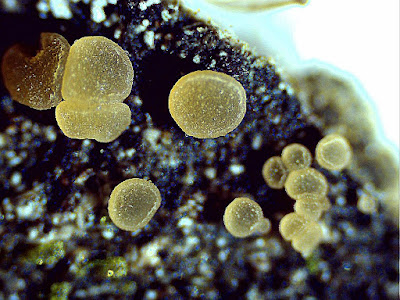Well November was good with ten new species for different counties so another six in this month was even a bigger surprise and some interesting species to boot! This was during a month when nothing happened due to a severe cold spell with heavy snow taking a week to disappear so making fungi hide for even longer. If I was a Mycena would I burrow out into the cold knowing there wasn't any foolish odd-ball fungi finder looking for me - of course not. Fortunately. Then we had Christmas - how else am I supposed to get new Fungi books? A short visit to my local patch at Bowbridge fields is where I found on a dead herbaceous plant base Acanthophiobolus helicosporus showing a few vertical setae from a minute asco body hiding between rows of common ascos. 2nd for Gloucs., but again probably not rare as maybe just a few people study these in the field with a hand lens. Also here living off a head high Salix branch on moss helped fix my eyes on the diminutive Chromocyphella muscicola. Looks so small, so easily mistaken for something to be ignored and virtually gill-less. On the same Salix tree a small resupinate growth suggested it should be looked at, especially as hidden in crevice of the branches and close to water. At home this emerged to be Eichleriella deglubens which has large allantoid spores. Whilst visiting my sister-in-law in North Wilts I took a walk around the farm where she lives. Picking up some maize stem debris from earlier in the year I found Gibberella zeae at the root of the plant. I let the farmer know what I had found in case he needed to know, I didn't get a Xmas Card so maybe that was his answer. 1st report for Wiltshire though! At Painswick Beacon among the Pinus and Fagus on the heathland, I found a modest looking smooth grey resupinate. This showed small warty globose spores - a very helpful guide to where to go, as well as other detail which made Hypochnicium punctulatum - 1st for Gloucs. Nearby in parkland under Boxus but on a stump of something else long ago was a cluster of Lachnum fasciclare. Always difficult to ID, especially when 'they' keep changing its name. Narrow lanceolated paraphyses and short hairs helped. Few county records. Back to the Salix at Bowbridge and the same tree produced a tiny white with basal disc Mycena. Careful study showed this to be Mycena clavularis - few records in Gloucs. Probably more common than perhaps records show as it is just so easy to dismiss. A trip back to my survey site at Ebworth NT Estate just before heavy snowfall was due paid off. On Alder/moss living branch near a stream I found the pale yellow ascomycete Parorbiliopsis minuta followed by a walk into nearby natural grasslands which had all the signs of past farming techniques with shelf type agriculture methods on banking evident. Here I was delighted to find a rare winter growing agaric species in Pseudoclitocybe expallens - similar to its look-a-like but which is found in woodlands. This also has its own detailed differences with mature specimens having inrolled crimped margins, unclamped and granular hyphae content as well as spore size and shape. New for Gloucs. and few other UK records. Lastly, venturing into a wet woodland by another stream (the Cotswolds are fortunate to have many springs starting within the many limestone based woodlands) I selected what appeared to be a Fagus rotten branch finding a dark looking resupinate. After the usual checks at home this turned into Tomentella badia - new for Gloucs and with only 20 others UK records. This genus is one of the hardest to decipher with very little differences between the many species - if you can find them as none are common. With this one I got lucky as it is one of the few without any clamps and the subhymenial hyphae turns blue in KOH. An irregular shaped warty mix of subglobose spores also helped. I look forward to the warmer weather in January 2023 as predicted and wonder what will be happening to fungi when the ground is harder or softer at times of the year they don't expect. No doubt they will adjust but might take a few years when early or late growth patterns start to emerge. They have already to me. I saw virtually NO waxcaps in and around Gloucs. this year - something I find astonishing. Hopefully they are having a break as other times they all come out at the same time. There seems to be an acute lack of Russulas also this year so I hope this also will change.
 |
| Acanthophiobolus helicosporus |
 |
| Chromocyphella muscicola growing on moss |
 |
| Chromocyphella muscicola |
 |
| Eichleriella deglubens |
 |
Gibberella zeae on Maize |
 |
| Lachnum fasciclare x40 |
 |
| Mycena clavularis |
 |
| Mycena clavularis |
 |
| Parorbiliopsis minuta asci |
 |
| Parorbiliopsis minuta |
 |
| Pseudoclitocybe expallens |
 |
| Pseudoclitocybe expallens |
 |
| Pseudoclitocybe expallens cuticle |
 |
| Tomentella badia |
 |
| Tomentella badia spores x1000 |
 |
| Tomentella badia hyphae changes |
No comments:
Post a Comment